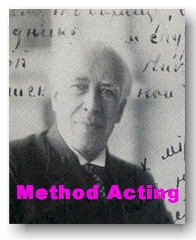Look, it will take a while to organize the links to each Part from the main directory -- and here is the real problem. You should know about shooting and shot, color and sound, editing before you edit and so on -- but since filmmaking is practical art and science, you have to MAKE it at the same time. I mean the mistakes. That's how you learn.
motion
Visual Composition
color
sound
shot
cut & Cutting
light
montage
* SHOT Analysis (reconstruction): draw the floor plan with the camera, actors and light positions (use one-shot form).
Shots
Time for camera to act...
 "CAMERA" -- oh, this magic point where the act of so many mixed into a new form...
"CAMERA" -- oh, this magic point where the act of so many mixed into a new form...
I couldn't write about it in Part I. Scripting (although the writing was done for the camera). I could talk about what camera in Part II. Preproduction, but that was a preporation, getting there. Only now camera acts...
Do you hear it? "Camera ready"?

And the answer -- "camera ready"...
Well, you can hear another questions and commands -- about sound, actors; and only if everything is ready for the camera, then -- ACTION!
On the camera page I can make only a few notes about "camera psychology" (that's why we do talk about "camera motivations"); what camera does, likes and how it behaves.
More important -- what camera doesn't do, what camera can't do!
What must be done for the camera.

Camera is a tool, like paint and canvas? What is the power of this "medium", what are the secrects this machine?
Paint and canvas are nothing, if you do not know how to use them. With camera the creative situation is more complex -- there are many artists who create at the same time -- and together. Like in theatre?
Well, in live theatre the artistic ingredients are mixed in the mind and heart of spectators. Here we have another modem before the spectator gets into act -- camera. Could I say that camera acts for spectator?
May I say that everything before "camera rolling" was nothing but pre-acting?

I struggle with words; "production" is one of them. "Production"? Why don't we call the writing music by composers -- production? Only because it done by one, like in poetry? Most of we know as art was done by one person. Theatre? What we know about about the live theatre? It does every night forever. Only the traces of it are left -- scripts, costumes, set designs... The twentieth century changed it. Now the collective "product" could overcome Father-Time, but in order to do it, we have to rearrange the process of creating it. We have to take live show apart -- segmentation of it we call shots.
"Cut!" -- we have to cut natural time into small pieces and put together again into most dramatic sequences. Camera cuts space, it's obvious (frame), but more interesting is how camera cuts time. We have to do it with "real time," because we have to turn time into "artistic medium" (subjective time).
Time and space (chronotope) are not ready for camera and our business and to change their nature, to "humanize" uniniverse without man...
 [ more later ]
[ more later ]
[ bring your "shot archeology" to class ]
[ recommended reading: ]
Get yourself another textbook -- I placed the Amazon link to Michael Rabiger's "Directing, film techniques and aesthetics" (3rd edition): see Part 7. Postproduction (p.493).






 amazon.com * movimaking online book * wikipedia
amazon.com * movimaking online book * wikipedia
 * Classes * Virtual Theatre * Bookmark vTheatre! Mailing List & News -- subscribe yourself * The Book of Spectator *
* Classes * Virtual Theatre * Bookmark vTheatre! Mailing List & News -- subscribe yourself * The Book of Spectator * 
 "CAMERA" -- oh, this magic point where the act of so many mixed into a new form...
"CAMERA" -- oh, this magic point where the act of so many mixed into a new form...



 [ more later ]
[ more later ]
 + film-analysis
[ breaking class into production groups: writer, director, cinematographer, producer ]
©2004 filmplus.org *
+ film-analysis
[ breaking class into production groups: writer, director, cinematographer, producer ]
©2004 filmplus.org *








